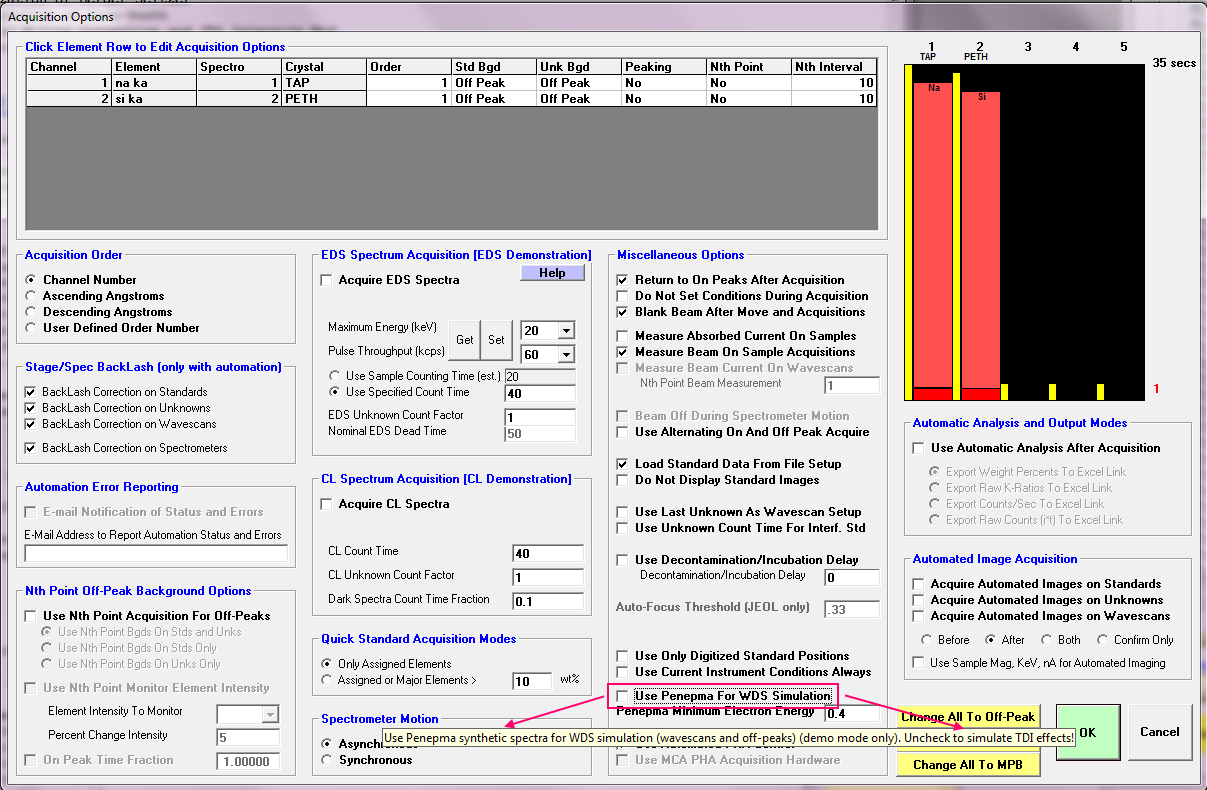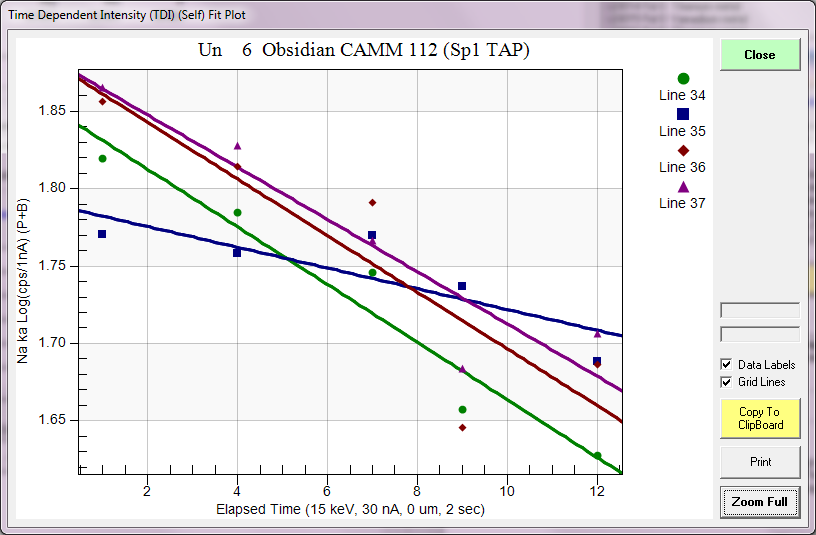It is worth mentioning that one can simulate time dependent intensity (TDI) effects in Probe for EPMA for teaching microprobe techniques. However, there are a few caveats:
1. First one needs to turn off the Penepma simulation mode for the TDI simulation using the checkbox as shown here:

Note also the "tooltip" pop up help that mentions this. The only downside of turning off the Penepma simulation is that wavescans will only contain a single peak for the specified emission line, but since the Penepma simulation can be turned off for (TDI) unknowns and/or standards and turned on for wavescans, this shouldn't be a problem.
2. So once the Penepma simulation is turned off and the TDI acquisition is turned on in the Special Options dialog, the first element in the acquisition will always utilize a "Na" type log-linear intensity decay, while the second element will always utilize a "Si" smaller log-linear increase in intensity as one would normally observe in an alkali glass specimen.
Therefore to simulate TDI effects when teaching EPMA please realize that these TDI effects will only be generated when Penepma simulations are turned off in the Acquisition Options dialog and "self" TDI acquisitions are selected in the Special Options dialog, both accessed from the Acquire! window.
Then you will be able to display simulated TDI intensities as shown here for the first element "Na":

And perform quantitative analyses of these "beam sensitive" materials for teaching in simulation or demonstration mode:
Un 6 Obsidian CAMM 112, Results in Elemental Weight Percents
ELEM: Na Si Ti Al Fe Mg Mn P Ca K H O
TYPE: ANAL ANAL SPEC SPEC SPEC SPEC SPEC SPEC SPEC SPEC SPEC SPEC
BGDS: LIN LIN
TIME: 10.00 10.00 --- --- --- --- --- --- --- --- --- ---
BEAM: 30.01 30.01 --- --- --- --- --- --- --- --- --- ---
ELEM: Na Si Ti Al Fe Mg Mn P Ca K H O SUM
34 3.044 33.456 .060 6.563 .909 .018 .015 .003 .322 3.761 .086 49.326 97.563
35 2.837 33.586 .060 6.563 .909 .018 .015 .003 .322 3.761 .086 49.326 97.486
36 3.127 33.961 .060 6.563 .909 .018 .015 .003 .322 3.761 .086 49.326 98.151
37 3.151 33.766 .060 6.563 .909 .018 .015 .003 .322 3.761 .086 49.326 97.980
AVER: 3.040 33.692 .060 6.563 .909 .018 .015 .003 .322 3.761 .086 49.326 97.795
SDEV: .143 .220 .000 .000 .000 .000 .000 .000 .000 .000 .000 .000 .322
SERR: .071 .110 .000 .000 .000 .000 .000 .000 .000 .000 .000 .000
%RSD: 4.70 .65 .00 .00 .00 .00 .00 .00 .00 .00 .00 .00
STDS: 336 14 --- --- --- --- --- --- --- --- --- ---
STKF: .0735 .4101 --- --- --- --- --- --- --- --- --- ---
STCT: 26.25 144.09 --- --- --- --- --- --- --- --- --- ---
UNKF: .0165 .2764 --- --- --- --- --- --- --- --- --- ---
UNCT: 5.90 97.12 --- --- --- --- --- --- --- --- --- ---
UNBG: .42 .86 --- --- --- --- --- --- --- --- --- ---
ZCOR: 1.8380 1.2188 --- --- --- --- --- --- --- --- --- ---
KRAW: .2249 .6741 --- --- --- --- --- --- --- --- --- ---
PKBG: 15.05 114.76 --- --- --- --- --- --- --- --- --- ---
TDI%: 10.394 -2.482 --- --- --- --- --- --- --- --- --- ---
DEV%: 1.5 .2 --- --- --- --- --- --- --- --- --- ---
TDIF: LOG-LIN LOG-LIN --- --- --- --- --- --- --- --- --- ---
TDIT: 13.00 13.00 --- --- --- --- --- --- --- --- --- ---
TDII: 6.36 97.9 --- --- --- --- --- --- --- --- --- ---
TDIL: 1.85 4.58 --- --- --- --- --- --- --- --- --- ---